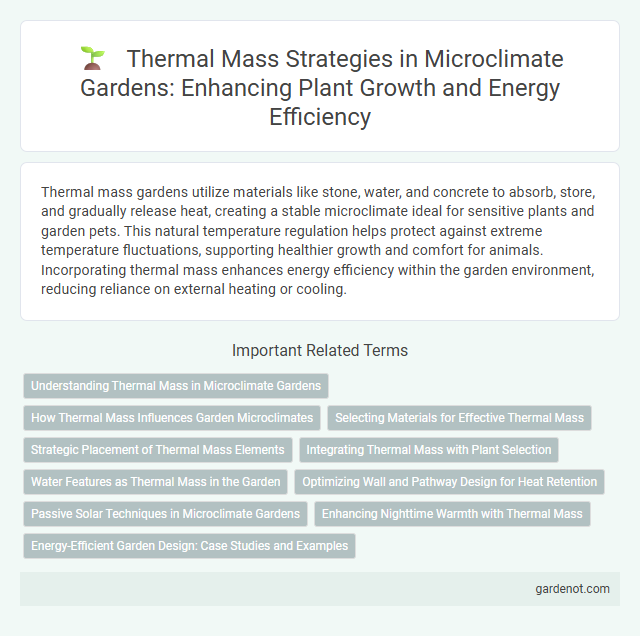Thermal mass gardens utilize materials like stone, water, and concrete to absorb, store, and gradually release heat, creating a stable microclimate ideal for sensitive plants and garden pets. This natural temperature regulation helps protect against extreme temperature fluctuations, supporting healthier growth and comfort for animals. Incorporating thermal mass enhances energy efficiency within the garden environment, reducing reliance on external heating or cooling.
Understanding Thermal Mass in Microclimate Gardens
Thermal mass in microclimate gardens refers to materials like stone, brick, or water that absorb, store, and gradually release heat, stabilizing temperature fluctuations. This process helps maintain a favorable microenvironment by warming plants during cold periods and cooling the garden during hot days. Incorporating thermal mass elements enhances plant growth, extends the growing season, and reduces energy needs for garden climate control.
How Thermal Mass Influences Garden Microclimates
Thermal mass in gardens stabilizes temperature fluctuations by absorbing heat during the day and releasing it at night, creating a moderated microclimate beneficial for plant growth. Materials such as stone, brick, or water features store solar energy and reduce frost risk by maintaining warmer nighttime temperatures. Optimizing thermal mass placement in garden design enhances plant resilience and extends growing seasons within microclimate zones.
Selecting Materials for Effective Thermal Mass
Selecting materials with high specific heat capacity and density, such as concrete, stone, and brick, enhances the effectiveness of thermal mass in a microclimate garden. These materials absorb heat during the day and slowly release it at night, stabilizing temperature fluctuations and creating a more favorable growing environment. Incorporating dark, dense surfaces maximizes solar heat absorption, improving the garden's overall energy efficiency.
Strategic Placement of Thermal Mass Elements
Strategic placement of thermal mass elements in a microclimate garden optimizes temperature regulation by absorbing heat during the day and releasing it at night, creating a more stable environment for plants. Positioning materials such as stone walls or water features on the south or southwest side maximizes solar gain, enhancing warmth in cooler seasons. Incorporating thermal mass near garden beds helps protect sensitive plants from temperature fluctuations, promoting healthier growth and extended growing seasons.
Integrating Thermal Mass with Plant Selection
Integrating thermal mass with plant selection enhances microclimate garden resilience by using materials like stone or water to absorb and release heat, stabilizing temperature fluctuations. Choosing plants tolerant to these moderated thermal conditions, such as heat-loving succulents or shade-preferring ferns, optimizes growth and reduces stress. This synergy between thermal mass and vegetation creates a balanced environment that supports diverse plant health and conserves energy.
Water Features as Thermal Mass in the Garden
Water features in a thermal mass garden regulate temperature by absorbing heat during the day and releasing it at night, stabilizing the microclimate. Ponds, fountains, and water tanks serve as effective thermal masses due to water's high specific heat capacity, which slows temperature fluctuations. Incorporating these elements supports plant growth and creates a balanced environment by moderating heat extremes in outdoor garden spaces.
Optimizing Wall and Pathway Design for Heat Retention
Thermal mass garden design utilizes materials such as brick, stone, or concrete in walls and pathways to absorb and slowly release heat, enhancing microclimate stability. Optimizing wall orientation and pathway placement maximizes sun exposure during the day, increasing heat retention and reducing temperature fluctuations at night. Incorporating dark-colored, dense materials in these elements improves thermal absorption, supporting plant growth and extending the growing season.
Passive Solar Techniques in Microclimate Gardens
Thermal mass gardens leverage passive solar techniques by incorporating materials like stone, concrete, or water that absorb, store, and slowly release heat, stabilizing microclimate temperatures. These elements moderate temperature fluctuations, extending growing seasons and enhancing plant vitality by maintaining warmth during cooler nights and cooler conditions during hot days. Optimizing thermal mass placement relative to sunlight exposure maximizes solar radiation capture, crucial for sustaining healthy microclimate garden ecosystems.
Enhancing Nighttime Warmth with Thermal Mass
Thermal mass materials such as stone, brick, or concrete absorb heat from sunlight during the day and release it slowly at night, significantly enhancing nighttime warmth in a microclimate garden. These materials stabilize temperature fluctuations, creating a more favorable environment for plants sensitive to cold temperatures. Proper placement of thermal mass near garden beds maximizes heat retention and extends the growing season by reducing frost risk.
Energy-Efficient Garden Design: Case Studies and Examples
Thermal mass gardens utilize materials like stone, brick, and water to absorb and store heat during the day, releasing it slowly at night to regulate microclimate temperatures efficiently. Case studies demonstrate that integrating thermal mass elements in garden design reduces heating and cooling energy consumption by stabilizing soil and air temperatures, promoting plant health and extending growing seasons. Examples include Mediterranean-inspired gardens employing thick masonry walls and water features that enhance energy efficiency through passive solar heating and thermal inertia.
Thermal mass garden Infographic

 gardenot.com
gardenot.com